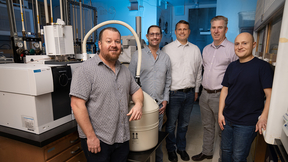Lab physicist's sensor work wins DARPA award
 (Download Image)
Vincent Tang, a physicist in the Engineering Directorate at Lawrence Livermore National Laboratory, was named as a Program Manager of the Year by the Defense Advanced Research Projects Agency (DARPA) for leading a program to develop and deploy networked sensors for dynamic, real-time radiological and nuclear threat detection over large urban areas. (Profile photo courtesy of DARPA)
(Download Image)
Vincent Tang, a physicist in the Engineering Directorate at Lawrence Livermore National Laboratory, was named as a Program Manager of the Year by the Defense Advanced Research Projects Agency (DARPA) for leading a program to develop and deploy networked sensors for dynamic, real-time radiological and nuclear threat detection over large urban areas. (Profile photo courtesy of DARPA)
The Defense Advanced Research Projects Agency (DARPA) named Lawrence Livermore National Laboratory engineer and physicist Vincent Tang as a Program Manager of the Year for 2016, recognizing him for leading a program involving multiple agencies to develop and deploy networked sensors for dynamic, real-time radiological and nuclear threat detection over large urban areas.
Since July 2013, Tang has been on assignment to DARPA’s Defense Sciences Office, where he has created and lead multiple efforts, including the SIGMA program. SIGMA is aimed at creating cost-effective, continuous, city-to-region-scale radiation-monitoring networks to help prevent attacks involving radiological "dirty bombs" and other nuclear threats. Key elements of this program, which began in 2014, have been to develop and test radiation sensors with an order of magnitude improvement in performance and cost compared to current technology, as well as to develop the ability to network and analyze up to 10,000 of the advanced detectors simultaneously to provide a comprehensive real-time overview of the radiological environment.
The program achieved its goal of producing and procuring 10,000 of these advanced detectors at $400 per unit in 2016. These new devices, when combined with larger SIGMA detectors along roadways, bridges and other infrastructure, promise significantly enhanced awareness of radiation sources and more advanced warning of possible threats, according to DARPA.
In October, Tang led the latest large-scale test of the SIGMA system, which deployed more than 1,000 networked, mobile radiation sensors in Washington, D.C. Earlier in the year, Tang also oversaw extended testing of the system at major transportation hubs in New York and New Jersey, according to DARPA. The tests resulted in unprecedented data collection and monitoring capability compared to existing systems, and required the coordinated efforts of multiple federal and municipal agencies, with participation ranging from the Department of Defense, Department of Homeland Security, Port Authority of New York and New Jersey, to hundreds of officers and volunteers.
More than 12 technical teams form the core of the SIGMA effort. At LLNL, researchers led by Simon Labov and David Campbell help develop, implement and test key algorithms on the system.
"I am really excited about the progress we have made so far. We’re at a point now where over the next two years, we’ll be fully operational and transitioning this capability to state and federal partners for protecting our cities," Tang said. "We envision this will be how we do city-scale radiological and nuclear threat detection in the years to come."
Tang is one of two program managers (out of about 100 at DARPA) to win the award for 2016.
"It was a very nice surprise. I am glad DARPA recognizes all the amazing work the SIGMA team accomplished in such a short time," Tang said. "It is a privilege to lead this team and to get our technology on the ground."
Tang is scheduled to return to LLNL in 2017, where he expects to continue work on issues of national security and nuclear terrorism.
Contact
 Jeremy Thomas
Jeremy Thomas
[email protected]
(925) 422-5539
Related Links
Advanced Radioactive Threat Detection System Completes First Large-Scale Citywide Test"Ushering in a New Generation of Low-Cost, Networked, Nuclear-Radiation Detectors"
Tags
DARPAEngineering
Defense
Featured Articles








